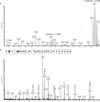Influence of carboxylation on osteocalcin detection by mass spectrometry
- PMID: 27470908
- PMCID: PMC5014568
- DOI: 10.1002/rcm.7692
Influence of carboxylation on osteocalcin detection by mass spectrometry
Abstract
Rationale: Osteocalcin is a small, abundant bone protein that is difficult to detect using high-throughput tandem mass spectrometry (MS/MS) proteomic approaches from bone protein extracts, and is predominantly detected by non-MS immunological methods. Here, we analyze bovine osteocalcin and its post-translational modifications to determine why a protein of this size goes undetected.
Methods: Osteocalcin was purified from cow bone using well-established methods. Intact osteocalcin or trypsin-digested osteocalcin were separated using an Agilent 1200 series high-performance liquid chromatography (HPLC) system and analyzed using a ThermoScientific LTQ-Orbitrap XL after fragmentation with higher-energy collision dissociation. Data were analyzed using Mascot or Prosight Lite.
Results: Our results support previous findings that the cow osteocalcin has up to three carboxylations using both intact osteocalcin and digested forms. Using Mascot, we were able to detect osteocalcin peptides, but no fragments that localized the carboxylations. Full annotation using Prosight Lite of the intact (three carboxylations), N-terminal peptide (one carboxylation), and middle peptide (two carboxylations) showed complete fragmentation was present, but complete neutral loss was observed.
Conclusions: Osteocalcin carboxylation, and its associated neutral losses, makes high-throughput detection of this protein challenging; however, alternative fragmentation or limited purification can overcome these challenges. Copyright © 2016 John Wiley & Sons, Ltd.
Copyright © 2016 John Wiley & Sons, Ltd.
Figures



References
Publication types
MeSH terms
Substances
Grants and funding
LinkOut - more resources
Full Text Sources
Other Literature Sources
